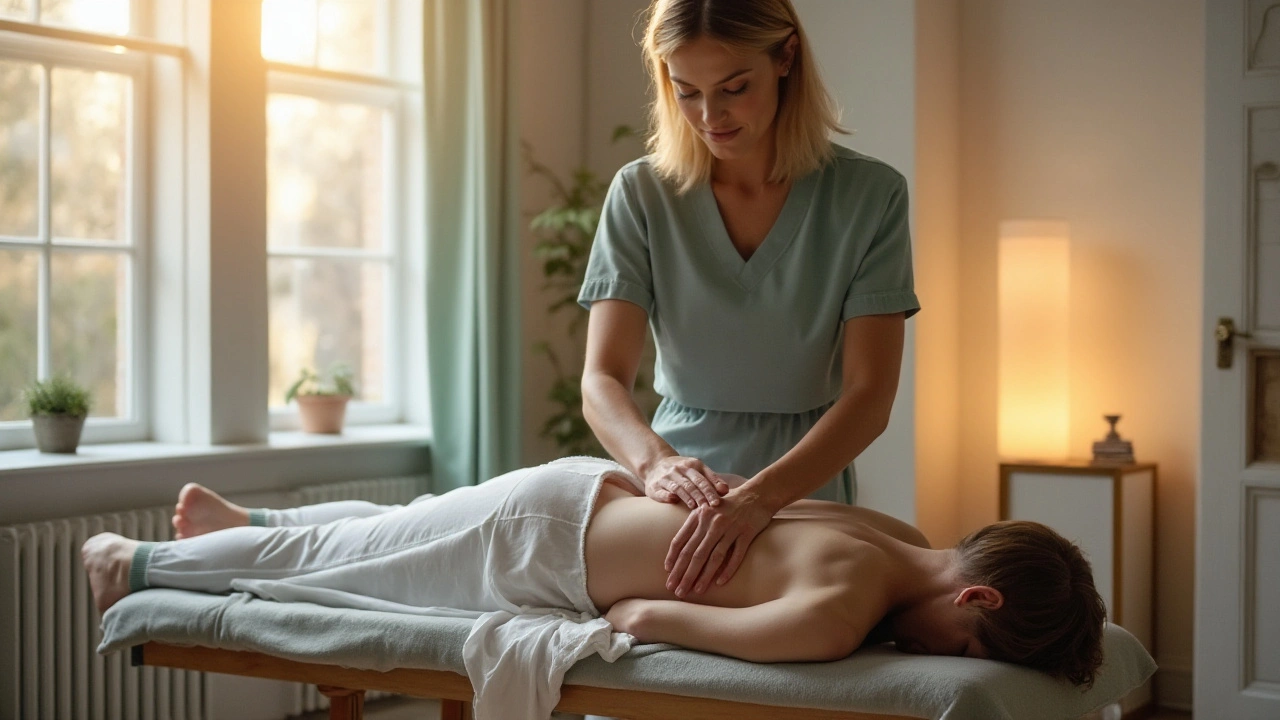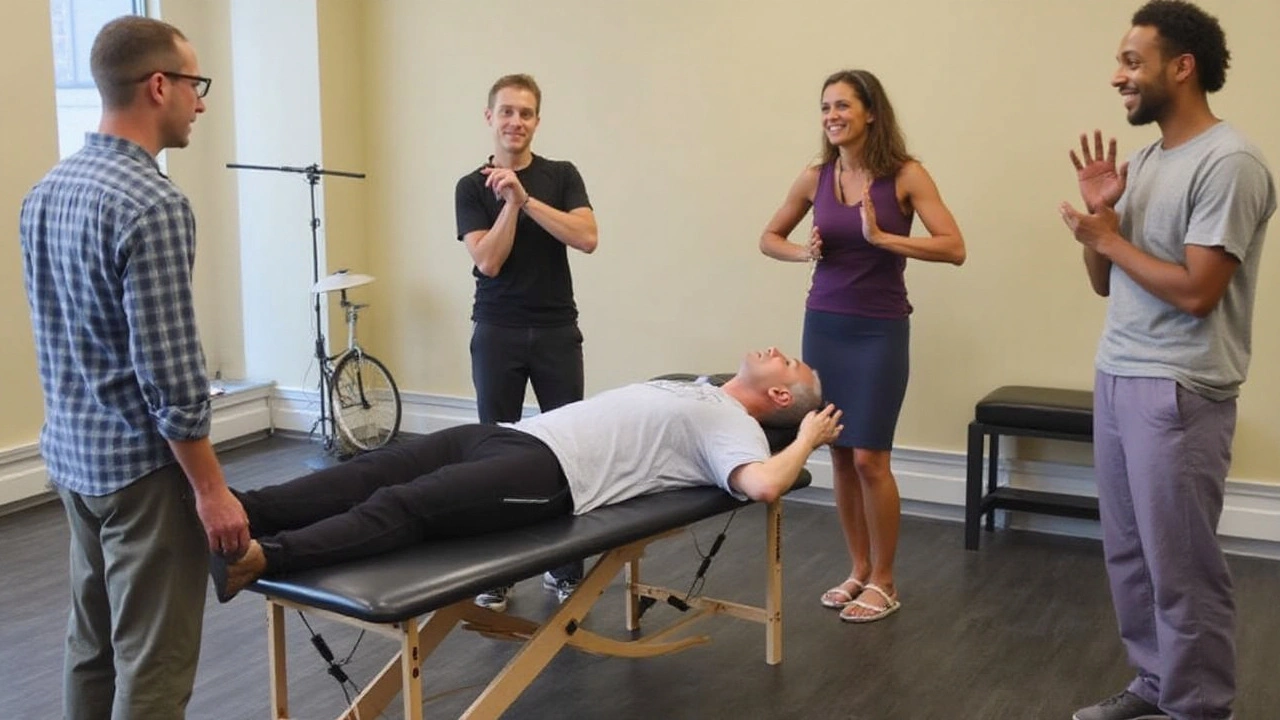Rolfing: Discover a Unique Approach to Body Wellness
 Sep, 29 2024
Sep, 29 2024
Rolfing, an innovative approach to bodywork, aims to improve posture and ease chronic pain by manipulating the body's connective tissues, known as fascia.
Originally developed in the mid-20th century, this technique focuses on realigning the body's structure to achieve proper balance.
Many individuals seek Rolfing to address a variety of issues, including back pain, poor posture, and even stress-related tension.
Understanding the principles of Rolfing and how it works can provide valuable insights into its potential benefits and what one might expect from a session.
- Understanding Rolfing
- History of Rolfing
- Benefits of Rolfing
- What to Expect in a Rolfing Session
- Tips for Choosing a Rolfing Practitioner
Understanding Rolfing
Rolfing is a specialized type of bodywork that focuses on the body's connective tissues, also known as fascia. This technique was developed by Dr. Ida Rolf in the 1940s and 1950s. She believed that proper alignment of the body can greatly improve overall health and functionality. By using manual manipulation, Rolfing aims to realign and balance the body, so that it can move more efficiently.
The fascia is a web-like structure that surrounds muscles, bones, and internal organs. When this connective tissue becomes tight or restricted, it can lead to poor posture, pain, and a decrease in mobility. The goal of Rolfing is to release these restrictions, allowing for better alignment and easier movement. This is achieved through a series of sessions, each focusing on different parts of the body. The practitioner uses their hands, fingers, and sometimes even elbows to apply pressure and stretch the fascia.
Rolfing is often compared to other forms of bodywork, like massage or chiropractic care, but there are distinct differences. While massage therapy focuses on relaxing the muscles through kneading and rubbing, Rolfing aims to restructure the body by focusing more on the connective tissues. Similarly, chiropractic care deals primarily with the alignment of the spine, whereas Rolfing takes a whole-body approach to alignment. According to Dr. Rolf, 'It's not the body. It’s the unconscious mind that’s making it tight.'
One of the key concepts of Rolfing is that the body is a holistic system. This means that a restriction in one part of the body can affect other parts. For example, a tightness in the lower back might lead to pain in the shoulders. By addressing the fascia and realigning the body, Rolfing aims to relieve these interconnected issues. This holistic approach is one of the reasons why many people turn to Rolfing for relief from chronic pain and other health issues.
Research has shown that Rolfing can have several benefits. A study published in the Journal of Bodywork and Movement Therapies found that Rolfing can significantly improve range of motion and reduce pain in individuals with chronic musculoskeletal issues. Another study conducted by the University of California, San Diego, reported that participants experienced a notable improvement in posture and balance after a series of Rolfing sessions. These findings support the idea that Rolfing can be an effective treatment for a variety of conditions.
While Rolfing can provide significant benefits, it is important to note that it is not a one-size-fits-all solution. The effectiveness of Rolfing can vary from person to person, depending on their specific issues and overall health. Some people might experience immediate relief after just a few sessions, while others might need a longer series of treatments. It’s always best to consult with a qualified Rolfing practitioner to determine what approach will work best for you.
History of Rolfing
The origins of Rolfing trace back to the mid-20th century when it was developed by Dr. Ida Rolf. Dr. Rolf, a biochemist from New York with a Ph.D. from Columbia University, experienced early in her career the limitations of traditional medical practices in addressing chronic pain and misalignment. Her quest led her to explore alternative methods of healing, including osteopathy, chiropractic medicine, and yoga.
Fuelled by her extensive studies and observations, Dr. Rolf formulated the theory that the body's structure affects its function. To address physical ailments, she created a unique system of hands-on manipulation that focused on the connective tissues or fascia. Her hypothesis suggested that by working on this web-like network, one could bring significant improvements in posture, flexibility, and overall wellness.
Initially called Structural Integration, Dr. Rolf's revolutionary method quickly gained a following. She founded the Rolf Institute of Structural Integration in Boulder, Colorado in 1971 to train practitioners in her technique. The term 'Rolfing' was coined by her students and clients as a tribute to her pioneering work. The practice then expanded internationally, with practitioners now found across the globe, bringing the benefits of body wellness to a diverse audience.
Dr. Rolf's work was met with both skepticism and enthusiasm. Critics questioned the scientific basis of her methods, while proponents cited its efficacy in alleviating pain and improving quality of life. Over the decades, the community of Rolfing practitioners has worked to validate and refine the technique, incorporating modern scientific findings to bolster its credibility and effectiveness.
“We must extend our knowledge of the structure and functioning of the human body in the gravitational field,” Dr. Ida Rolf once said, emphasizing the critical importance of understanding how the body interacts with gravity over time.
Today, Rolfing is recognized as a powerful tool for not only addressing physical discomfort but also for promoting a sense of wellbeing. This historical journey from a single woman's vision to a globally respected therapy underscores the significant impact of holistic approaches in modern healing practices.

Benefits of Rolfing
Rolfing offers numerous benefits for both physical and mental well-being. One of its primary advantages is the improvement in body wellness. By focusing on the body's connective tissues or fascia, Rolfing helps to realign and balance the body. This realignment can lead to better posture and a more efficient movement pattern. Many people experience relief from chronic pain, especially in areas like the back, shoulders, and neck.
Another significant benefit is its potential to reduce stress and tension. When the fascia is manipulated, it often releases stored tension that may have accumulated over years. This can lead to a feeling of overall relaxation and emotional release. Some people even report feeling lighter or more at ease after a session.
In addition to these physical benefits, Rolfing can enhance athletic performance. Improved alignment and posture enable athletes to move more efficiently and with less strain on their bodies, which can lead to better performance and fewer injuries. This is why many professional athletes incorporate Rolfing into their training routines.
Enhanced flexibility is another notable benefit. As the fascia is realigned, the body becomes less restricted and joints gain a greater range of motion. This can be particularly helpful for those who suffer from stiffness or have a limited range of movement.
Moreover, Rolfing can impact the nervous system positively. A more balanced and aligned body can lead to improved nerve function and communication throughout the body. This can enhance one's overall sense of well-being and even improve certain health conditions related to nerve dysfunction.
According to Dr. Ida Rolf, the founder of Rolfing, "When the body gets working appropriately, the force of gravity can flow through. Then, spontaneously, the body heals itself." This highlights how Rolfing aligns with the body's natural healing processes.
Many people also find that Rolfing enhances their body awareness. By becoming more attuned to their alignment and movement patterns, individuals can make more conscious decisions about how they move and hold themselves daily. This increased awareness can lead to lasting changes in habits and a more mindful approach to one's body.
It's essential to note that Rolfing is not a one-size-fits-all solution. The benefits may vary from person to person depending on their specific needs, conditions, and goals. However, the holistic nature of Rolfing often means that multiple aspects of well-being are addressed in each session.
What to Expect in a Rolfing Session
When you walk into a Rolfing session, you might feel a mixture of curiosity and nervousness, especially if it's your first time. The session usually begins with an initial consultation where the practitioner takes the time to understand your body, your history, and your specific needs. This consultation is crucial as it helps the Rolfer identify the areas that require the most attention and it sets the tone for the sessions to come.
Once the consultation is done, you move to a comfortable massage table. Unlike traditional massages, Rolfing employs slower, deeper strokes that work on the connective tissues. The goal is not just to relieve tension, but to reorganize the fascia and encourage better posture and alignment. This process might be slightly uncomfortable at times, but it shouldn't be painful. Communication with your Rolfer is key to ensuring the right pressure is applied.
The initial session often involves examining how you stand, walk, and sit. This functional assessment helps the practitioner tailor the Rolfing techniques to your body's unique structure. Many who've undergone Rolfing suggest wearing minimal clothing like underwear or a swimsuit to allow the Rolfer better access to the fascia while maintaining comfort.
Each session lasts about 60 to 90 minutes and follows a systematic approach, usually starting with the superficial layers and gradually working into deeper tissues. The number of sessions can vary based on your goals and the specific issues you're addressing, but a standard Rolfing series consists of ten sessions. This “Ten Series” is designed to address all aspects of body alignment and integration.
During these sessions, don't be surprised if you feel a range of emotions. The manipulation of connective tissue can sometimes release stored emotions, leading to unexpected tears or laughter. This emotional release is a normal part of the Rolfing process and speaks to its holistic nature, which aims to heal both body and mind.
Post-session, many people report feeling lighter, more balanced, and more aware of their bodies. It's also common to feel some temporary soreness, similar to what you might experience after a deep-tissue massage. Drink plenty of water and allow your body some time to adjust to the changes.
“Rolfing is not about getting fixed; it's about the process of letting go and integrating new ways of being,” says Dr. Ida Rolf, the founder of Rolfing.
If you're committed to the process, you might start noticing long-term benefits like improved posture, decreased pain, and enhanced bodily function. The key is consistency and staying mindful of the changes happening in your body.
So, if you're considering Rolfing as a potential path to better wellness, knowing what to expect can help you prepare mentally and physically for the journey ahead. It’s more than just a quick fix; it’s an opportunity to reset and realign your body for lasting benefits.

Tips for Choosing a Rolfing Practitioner
Finding the right Rolfing practitioner is crucial in ensuring you get the best results from your sessions. Although Rolfing is a specialized field, a knowledgeable and experienced practitioner can make a significant difference in your body's healing process. First and foremost, make sure the practitioner is certified by the Rolf Institute of Structural Integration or an equivalent accredited body. Certification guarantees that the practitioner has completed the necessary training and adheres to professional standards.
Another important factor to consider is experience. An experienced practitioner likely has encountered a wide range of issues and can better tailor their approach to suit your specific needs. Do not hesitate to ask them about their years in practice and what types of conditions they have treated. Often, seasoned practitioners can offer a more nuanced understanding of body wellness and how to achieve it.
Personal connection also plays a role in your comfort and the effectiveness of the treatment. During your initial consultation, assess whether you feel at ease with the practitioner. Open communication is essential, as you need to be able to discuss your concerns and expectations freely. Trust your instincts—if something feels off, it might be worth considering someone else.
Feedback from previous clients can offer invaluable insights into a practitioner's capabilities. Look for testimonials and online reviews to get a sense of what others have experienced. Some practitioners may also provide references upon request. Hearing about the success stories and experiences of others can be reassuring and help you make an informed decision.
Location and convenience matter, too. Ideally, choose a practitioner whose office is within a reasonable distance from your home or workplace. Frequent sessions can become cumbersome if you have to travel long distances, and convenience can often make a significant difference in your commitment to ongoing therapy.
Cost is another consideration, but it should not be the only deciding factor. While it's tempting to opt for the least expensive option, keep in mind that a highly qualified and experienced practitioner might charge more for their services. Remember, this is an investment in your health and well-being. Find out if there are package deals or sliding scale fees to help make regular sessions more affordable.
Lastly, consider the practitioner’s approach and methodology. Some may use a more clinical approach, while others may integrate additional holistic practices such as yoga or meditation. Ask questions about their techniques to ensure their style aligns with your preferences and comfort level. You want a practitioner who complements your philosophy toward health and body wellness.
Dr. Ida Rolf, the founder of Rolfing, once said, "It is easier to build strong children than to repair broken men." This quote underscores the importance of starting Rolfing therapy with the right practitioner to pave the way for lasting wellness.
Investing time to find the right Rolfing practitioner can significantly enhance your experience and results. Trust your instincts, do your homework, and don't be afraid to ask questions. Your body will thank you for it.
